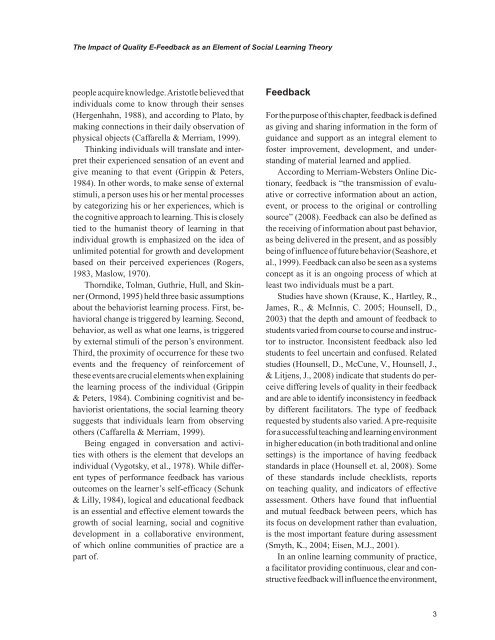Web-based Learning Solutions for Communities of Practice
Web-based Learning Solutions for Communities of Practice
Web-based Learning Solutions for Communities of Practice
You also want an ePaper? Increase the reach of your titles
YUMPU automatically turns print PDFs into web optimized ePapers that Google loves.
The Impact <strong>of</strong> Quality E-Feedback as an Element <strong>of</strong> Social <strong>Learning</strong> Theory<br />
people acquire knowledge. Aristotle believed that<br />
individuals come to know through their senses<br />
(Hergenhahn, 1988), and according to Plato, by<br />
making connections in their daily observation <strong>of</strong><br />
physical objects (Caffarella & Merriam, 1999).<br />
Thinking individuals will translate and interpret<br />
their experienced sensation <strong>of</strong> an event and<br />
give meaning to that event (Grippin & Peters,<br />
1984). In other words, to make sense <strong>of</strong> external<br />
stimuli, a person uses his or her mental processes<br />
by categorizing his or her experiences, which is<br />
the cognitive approach to learning. This is closely<br />
tied to the humanist theory <strong>of</strong> learning in that<br />
individual growth is emphasized on the idea <strong>of</strong><br />
unlimited potential <strong>for</strong> growth and development<br />
<strong>based</strong> on their perceived experiences (Rogers,<br />
1983, Maslow, 1970).<br />
Thorndike, Tolman, Guthrie, Hull, and Skinner<br />
(Ormond, 1995) held three basic assumptions<br />
about the behaviorist learning process. First, behavioral<br />
change is triggered by learning. Second,<br />
behavior, as well as what one learns, is triggered<br />
by external stimuli <strong>of</strong> the person’s environment.<br />
Third, the proximity <strong>of</strong> occurrence <strong>for</strong> these two<br />
events and the frequency <strong>of</strong> rein<strong>for</strong>cement <strong>of</strong><br />
these events are crucial elements when explaining<br />
the learning process <strong>of</strong> the individual (Grippin<br />
& Peters, 1984). Combining cognitivist and behaviorist<br />
orientations, the social learning theory<br />
suggests that individuals learn from observing<br />
others (Caffarella & Merriam, 1999).<br />
Being engaged in conversation and activities<br />
with others is the element that develops an<br />
individual (Vygotsky, et al., 1978). While different<br />
types <strong>of</strong> per<strong>for</strong>mance feedback has various<br />
outcomes on the learner’s self-efficacy (Schunk<br />
& Lilly, 1984), logical and educational feedback<br />
is an essential and effective element towards the<br />
growth <strong>of</strong> social learning, social and cognitive<br />
development in a collaborative environment,<br />
<strong>of</strong> which online communities <strong>of</strong> practice are a<br />
part <strong>of</strong>.<br />
Feedback<br />
For the purpose <strong>of</strong> this chapter, feedback is defined<br />
as giving and sharing in<strong>for</strong>mation in the <strong>for</strong>m <strong>of</strong><br />
guidance and support as an integral element to<br />
foster improvement, development, and understanding<br />
<strong>of</strong> material learned and applied.<br />
According to Merriam-<strong>Web</strong>sters Online Dictionary,<br />
feedback is “the transmission <strong>of</strong> evaluative<br />
or corrective in<strong>for</strong>mation about an action,<br />
event, or process to the original or controlling<br />
source” (2008). Feedback can also be defined as<br />
the receiving <strong>of</strong> in<strong>for</strong>mation about past behavior,<br />
as being delivered in the present, and as possibly<br />
being <strong>of</strong> influence <strong>of</strong> future behavior (Seashore, et<br />
al., 1999). Feedback can also be seen as a systems<br />
concept as it is an ongoing process <strong>of</strong> which at<br />
least two individuals must be a part.<br />
Studies have shown (Krause, K., Hartley, R.,<br />
James, R., & McInnis, C. 2005; Hounsell, D.,<br />
2003) that the depth and amount <strong>of</strong> feedback to<br />
students varied from course to course and instructor<br />
to instructor. Inconsistent feedback also led<br />
students to feel uncertain and confused. Related<br />
studies (Hounsell, D., McCune, V., Hounsell, J.,<br />
& Litjens, J., 2008) indicate that students do perceive<br />
differing levels <strong>of</strong> quality in their feedback<br />
and are able to identify inconsistency in feedback<br />
by different facilitators. The type <strong>of</strong> feedback<br />
requested by students also varied. A pre-requisite<br />
<strong>for</strong> a successful teaching and learning environment<br />
in higher education (in both traditional and online<br />
settings) is the importance <strong>of</strong> having feedback<br />
standards in place (Hounsell et. al, 2008). Some<br />
<strong>of</strong> these standards include checklists, reports<br />
on teaching quality, and indicators <strong>of</strong> effective<br />
assessment. Others have found that influential<br />
and mutual feedback between peers, which has<br />
its focus on development rather than evaluation,<br />
is the most important feature during assessment<br />
(Smyth, K., 2004; Eisen, M.J., 2001).<br />
In an online learning community <strong>of</strong> practice,<br />
a facilitator providing continuous, clear and constructive<br />
feedback will influence the environment,<br />
3



